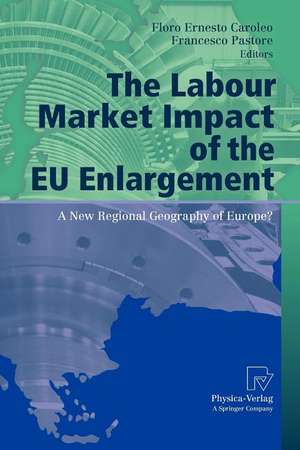The Labour Market Impact of the EU Enlargement: A New Regional Geography of Europe?: AIEL Series in Labour Economics
Editat de Floro Ernesto Caroleo, Francesco Pastoreen Limba Engleză Paperback – 28 mai 2012
| Toate formatele și edițiile | Preț | Express |
|---|---|---|
| Paperback (1) | 643.34 lei 6-8 săpt. | |
| Physica-Verlag HD – 28 mai 2012 | 643.34 lei 6-8 săpt. | |
| Hardback (1) | 649.71 lei 6-8 săpt. | |
| Physica-Verlag HD – 14 apr 2010 | 649.71 lei 6-8 săpt. |
Preț: 643.34 lei
Preț vechi: 756.86 lei
-15% Nou
Puncte Express: 965
Preț estimativ în valută:
123.10€ • 128.85$ • 102.46£
123.10€ • 128.85$ • 102.46£
Carte tipărită la comandă
Livrare economică 31 martie-14 aprilie
Preluare comenzi: 021 569.72.76
Specificații
ISBN-13: 9783790828207
ISBN-10: 3790828203
Pagini: 356
Ilustrații: XIV, 342 p. 59 illus.
Dimensiuni: 155 x 235 x 19 mm
Greutate: 0.5 kg
Ediția:2010
Editura: Physica-Verlag HD
Colecția Physica
Seria AIEL Series in Labour Economics
Locul publicării:Heidelberg, Germany
ISBN-10: 3790828203
Pagini: 356
Ilustrații: XIV, 342 p. 59 illus.
Dimensiuni: 155 x 235 x 19 mm
Greutate: 0.5 kg
Ediția:2010
Editura: Physica-Verlag HD
Colecția Physica
Seria AIEL Series in Labour Economics
Locul publicării:Heidelberg, Germany
Public țintă
ResearchCuprins
An Overview of the Main Issues and the Role of Structural Change.- Structural Change and Labour Reallocation Across Regions: A Review of the Literature.- Organized Labour and Restructuring: Coal Mines in the Czech Republic and Romania.- New Evidence on Spatial Convergence.- Labour Productivity Polarization Across Western European Regions: Threshold Effects Versus Neighbourhood Effects.- Transition, Regional Features, Growth and Labour Market Dynamics.- Regional Dynamics of Unemployment in Poland A Convergence Approach.- Spatial Distribution of Key Macroeconomic Growth Indicators in the EU-27: A Theoretical and Empirical Investigation.- Is Migration Reinforcing Regional Unemployment Differences?.- Internal Labour Mobility in Central Europe and the Baltic Region: Evidence from Labour Force Surveys.- Spatial Search and Commuting with Asymmetric Changes of the Wage Distribution.- Where Do the Brainy Italians Go?.- Some Policy Tools.- Assessing Active Labour Market Policies in Transition Economies.- Regional Female Labour Force Participation: An Empirical Application with Spatial Effects.
Recenzii
From the reviews:
“This book deals with a highly topical issue: various labour market impacts of the recent EU enlargement. The book consists of a number of research papers that were originally presented at a seminar. … the book provides several important new insights about structural change and regional labour markets in Europe. I can recommend it to anyone who is interested in regional labour market analysis with a European focus.” (Petri Böckerman, Journal of Economic Geography, Vol. 12 (4), July, 2012)
“This book collects a number of thought-provoking papers and raises important policy-relevant issues with respect to structural change, convergence, labour mobility and regional labour market policy in the EU that are likely to inspire further research. Furthermore readers … will find the literature surveys both in the review and in most of the research papers useful.” (Peter Huber, Scienze Regionali, Vol. 11 (2), 2012)
“The book’s chapters (essays) are able to capture the main issues under discussion, while also providing a comprehensive set of theoretical and econometric methodologies used in the field of contemporary regional economic research. … The book is useful to all academics, university students of economics - especially labor economics - as well as bureaucrats in international organizations and policy makers and union members interested in these themes. Thus, they can broaden and enrich their knowledge of such important issues of the day.” (Alka Obadić, Croatian Economic Survey, Vol. 13 (1), April, 2011)
“This book deals with a highly topical issue: various labour market impacts of the recent EU enlargement. The book consists of a number of research papers that were originally presented at a seminar. … the book provides several important new insights about structural change and regional labour markets in Europe. I can recommend it to anyone who is interested in regional labour market analysis with a European focus.” (Petri Böckerman, Journal of Economic Geography, Vol. 12 (4), July, 2012)
“This book collects a number of thought-provoking papers and raises important policy-relevant issues with respect to structural change, convergence, labour mobility and regional labour market policy in the EU that are likely to inspire further research. Furthermore readers … will find the literature surveys both in the review and in most of the research papers useful.” (Peter Huber, Scienze Regionali, Vol. 11 (2), 2012)
“The book’s chapters (essays) are able to capture the main issues under discussion, while also providing a comprehensive set of theoretical and econometric methodologies used in the field of contemporary regional economic research. … The book is useful to all academics, university students of economics - especially labor economics - as well as bureaucrats in international organizations and policy makers and union members interested in these themes. Thus, they can broaden and enrich their knowledge of such important issues of the day.” (Alka Obadić, Croatian Economic Survey, Vol. 13 (1), April, 2011)
Textul de pe ultima copertă
Until recently, regional labour market imbalances were considered transitory phenomena, a consequence of state failure in generating distorted investment incentives in depressed regions as well as of excessive labour market rigidities. Labour mobility and wage flexibility were at the core of the debate over the causes of and cures for regional labour market imbalances. This book bears witness to the changed perspective of research on these issues. In the recent literature, internal labour migration is depicted as a cause of further divergence between advanced and backward regions, as higher returns on human and physical capital are expected to be paid in those regions where these factors are already concentrated.
The book contributes to the debate by presenting important new findings on: a) the reasons why structural change in some sectors causes a slump in some regions, but not in others; b) the extent to which poverty traps explain regional imbalances as compared to such other alternative factors as spatial dependence and nonlinearity in growth behaviour; c) the degree of convergence across EU countries and regions; d) the role of labour mobility in reducing/increasing regional labour market imbalances, in particular in Central and Eastern Europe; e) and the role of an active labour market policy and child care facilities in alleviating the hardship of the weakest segments of the population.
The book contributes to the debate by presenting important new findings on: a) the reasons why structural change in some sectors causes a slump in some regions, but not in others; b) the extent to which poverty traps explain regional imbalances as compared to such other alternative factors as spatial dependence and nonlinearity in growth behaviour; c) the degree of convergence across EU countries and regions; d) the role of labour mobility in reducing/increasing regional labour market imbalances, in particular in Central and Eastern Europe; e) and the role of an active labour market policy and child care facilities in alleviating the hardship of the weakest segments of the population.
Caracteristici
Includes supplementary material: sn.pub/extras




















